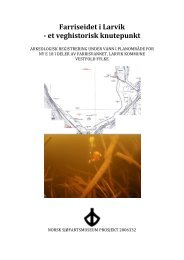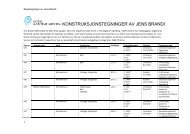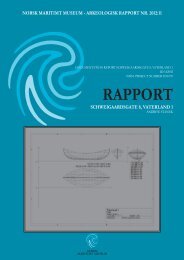Last ned 2009230_Rapport_Sørenga9_liten.pdf - Norsk Maritimt ...
Last ned 2009230_Rapport_Sørenga9_liten.pdf - Norsk Maritimt ...
Last ned 2009230_Rapport_Sørenga9_liten.pdf - Norsk Maritimt ...
Create successful ePaper yourself
Turn your PDF publications into a flip-book with our unique Google optimized e-Paper software.
X055: from x004 S08<br />
Two separate pieces of caulking cord.<br />
(a) 1.55m (1500mm) long x 20 x 10mm, varying in thickness along length; in places there are two<br />
parallel cords; plied S2Z, angle of helix variable, around 20°.<br />
(b) 330 m long x 25 x 6 mm; plied S2Z, 25-30°.<br />
Fibre<br />
Animal fibres, not in intact staples. Range 24-70 microns (based on 25 fibres). Pigmentation<br />
moderate on coarser fibres, absent on rest. Medullas present on 60%, some wide continuous,<br />
some narrow continuous. Scale pattern irregular waved mosaic with smooth margins. Crosssections<br />
oval and elliptical. Young CATTLE.<br />
X067: caulking from the inside land edge of 009 del A.<br />
Two fragments of heavily felted material possibly caulking cords which have become matted<br />
together. One fragment is 0.46m (460mm) long and the other 180mm long, and both are 35 x<br />
8-10 mm across. Some strands, 2 mm thick, running diagonally across the surface may represent<br />
some form of loose stitching.<br />
Fibre<br />
Animal fibre still with remains of intact staples, 50-60 mm long with roots, but no tips present.<br />
Double-coated, with a fine undercoat, 10-30 microns diameter (mode 14 microns) and coarse<br />
outer coat, 55-137 microns. Pigmentation moderate on outer coat fibres (brown). Medullas on<br />
outer coat, wide and continuous, latticed type; also interrupted medulla on some of the finer<br />
fibres. Scale pattern poorly preserved. GOAT<br />
Sørenga 9<br />
X019: from plank 010 (NIKU F621) from under x009<br />
A rectangular fragment of textile, 0.24 x 0.12m, woven in 2/1 twill, with a Z-wise wale, 7/Z/1.2 x<br />
5/S/2.0 per cm, very slightly matted on the S-face. Thicker S-spun yarns (2.5 mm diameter)<br />
running along one transverse edge may represent the remains of starting border. One edge<br />
certainly cut, the others cut or torn. Four nail holes, 2-4 mm diameter, form the corners of an<br />
invisible rectangle approximately 150 x 8 mm.<br />
Fibre<br />
WOOL, moderately pigmented throughout, darkest fibres in the Z-spun system: originally<br />
brown.<br />
X020: from boat part 005 (NIKU F622) from under barrel stave used for repair.<br />
Two fragments of textile, one of which has a further small fragment attached.<br />
(a) An irregular long triangle, 0.38 x 0.11m, of 2/1 twill with a Z-wise wale, 6/Z/1.5 x 4/S/2.0 per<br />
cm; close and slightly matted. All three edges are torn. There is a single rivet hole. 3mm square,<br />
in the middle of the fragment. A rolled piece of a similar textile, running at right angles to the<br />
weave of the first, is fixed firmly to the surface, although no stitching is visible.<br />
Fibre<br />
WOOL, from a double-coated sheep, with kemp; 20-30% pigmented (brown) fibres in Z-spun,<br />
10-20% same in S-spun.<br />
(b) A rectangle, 210 x 90 mm, of 2/1 twill with a Z-wise wale, 7/Z/1.2 x 5/S/1.5 per cm; close and<br />
dense: possibly different from (a). At least one edge has been cut. There is a rivet hole, 3 mm<br />
square, towards one edge.<br />
2








